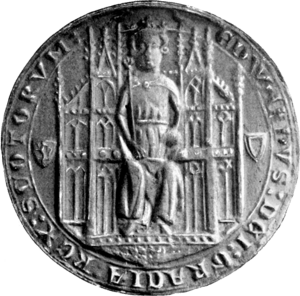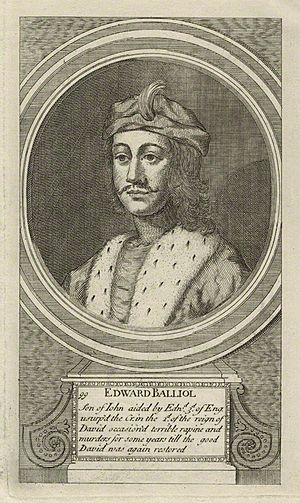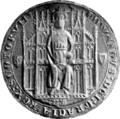Edward Balliol facts for kids
Quick facts for kids Edward Balliol |
|
|---|---|

Edward's seal
|
|
| Claimant to the throne of the Kingdom of Scotland | |
| Tenure | 24 September 1332 – 20 January 1356 |
| Born | c. 1283 Cavers, Roxburghshire, Kingdom of Scotland |
| Died | January 1364 (aged around 81) Wheatley, Doncaster, Kingdom of England |
| House | Balliol |
| Father | John Balliol |
| Mother | Isabella de Warenne |
| Religion | Roman Catholicism |
Edward Balliol (Scottish Gaelic: Èideard Balliol; born around 1283 – died January 1364) wanted to be the King of Scotland. He fought for the Scottish throne during a time known as the Second War of Scottish Independence. With help from England, he ruled parts of Scotland from 1332 to 1356.
Contents
Edward's Early Life
Edward was the oldest son of John Balliol and Isabella de Warenne. When he was a child, he was supposed to marry Isabelle of Valois. She was the daughter of Charles, Count of Valois.
However, Edward's father, John, gave up his title as King of Scotland in 1296. Because of this, the King of France broke off the marriage plans for Edward and Isabelle. Isabelle later married someone else.
After his father stepped down as king, Edward lived in the Tower of London. He was later released and lived with his grandfather. Edward might have been involved in a secret plan to remove King Robert I from the throne. This plan was led by William II de Soules.
Fighting for the Scottish Throne
King Robert I died in June 1329. His son, David II, was only six years old. So, Thomas Randolph, a trusted leader, became the regent. A regent is someone who rules for a young king.
Around this time, Edward Balliol joined a group called "the disinherited." These were men whose lands in Scotland had been taken away by King Robert I. They wanted their lands back. This group included important people like Henry de Beaumont.
In 1332, Edward and the disinherited planned to invade Scotland. Edward III of England secretly supported them. After the regent Thomas Randolph died in July 1332, Edward's forces attacked. They defeated the new regent, the Earl of Mar, at the Battle of Dupplin Moor on August 11, 1332.
Edward's Crowning and Challenges
Edward Balliol was crowned King of Scotland at Scone on September 24, 1332. But his rule did not last long. Three months later, nobles loyal to David II launched a surprise attack at the Battle of Annan. Edward was forced to escape back to England. He found safety in castles owned by the Clifford family in Westmorland.
In early 1333, Edward III of England openly supported Balliol. Edward Balliol returned to Scotland with an English army. They captured the town of Berwick and won a big battle at Battle of Halidon Hill.
After this victory, Balliol made a deal with Edward III. He gave a large area of Scotland called Lothian to Edward. He also promised to be Edward's loyal lord. Edward III's sister, Joan, was already married to David II. But Balliol was also promised to marry her.
Even though David II fled Scotland to France, Edward Balliol's position was still not safe. His own supporters argued, and forces loyal to David II kept fighting. Balliol had to flee Scotland again.
More Invasions and Defeats
In November 1334, Edward III and Balliol invaded Scotland once more. But they could not get the Scottish army to fight a big battle. They went back to England in February 1335.
On November 30, 1335, an army supporting Balliol was defeated at the Battle of Culblean. This battle pretty much ended Balliol's main attempt to take over the Scottish throne.
In early 1336, a truce was suggested. It would have made Balliol king and David II his heir. But David rejected this idea. Edward III and Balliol invaded again in July 1336 with a large English army. They marched through Scotland, destroying the countryside.
However, by late 1336, the Scots had taken back control of almost all of Scotland. By 1338, things were going badly for Balliol.
Edward Balliol returned to Scotland one last time after King David II was defeated at the Battle of Neville's Cross in 1346. With a small force, he tried to start a rebellion in Galloway. He only managed to control some parts of Galloway, and his power there slowly disappeared by 1355.
Edward's Final Years
On January 20, 1356, Edward Balliol gave up his claim to the Scottish throne. He gave it to Edward III of England. In return, he received money from England every year.
He spent the rest of his life living near Yorkshire, England. Edward Balliol died in January 1364, at Wheatley, Doncaster. He had no children. People think his grave might be under a Post Office in Doncaster.
Images for kids
See also
 In Spanish: Eduardo de Balliol para niños
In Spanish: Eduardo de Balliol para niños




